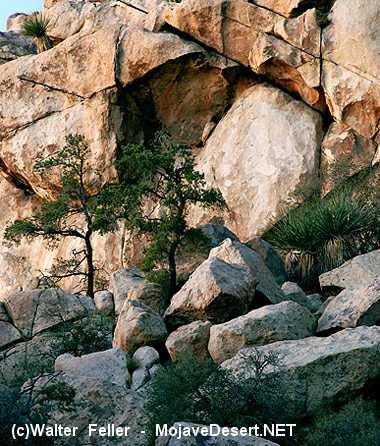Desert Indians : Plants
Indian use of Native Plants
Native plants were very essential to Native Americans living in the desert. They provided almost everything necessary for survival and culture. In the Mojave Desert, these plants served as food, medicine, tools, clothing, and spiritual practices for the people. This made the hostile desert environment not just survivable but an integral part of their lifestyle.Survival Must-Haves
Honey Mesquite
Though unassuming, the honey mesquite was a requisite. Its straw-colored pods were an important source of high-protein food, eaten fresh, dried, or ground into meal for cakes or drinks. Mesquite wood was used to fuel fires and as material for making bows, arrows, and roofs. Bark was used for kindling, nets, clothing, and even diapers for infants.Pinyon Pine
The pinyon pine grows in high places and gives nuts that people gather before animals can take them. Roasting the green cones makes the nuts come out, and they were eaten whole, ground into a meal, or used as baby food. People made baskets from pine needles, and resin was used to glue tools and fix pottery. Pinyon branches and bark were used for firewood and roofing.Oak
Acorns from oak trees were a crucial source of food. One tree could produce hundreds of pounds over a few years. After removing the bitter tannins, acorns were ground into meal or kept in elevated granaries to keep pests away. Oaks also provided wood for cooking and heating, and acorns were used for bait, trade, and even making toys.More Food Plants
Desert tribes like the Cahuilla, Serrano, and Mohave used nearly every plant they could find. The fan palms provided sweet fruits, while the jojoba nuts were crushed to make meal or drinks. Roasted yucca stalks and chia seeds helped feed them, especially on long trips. Chia was especially valued for its ability to give energy.Medicinal Plants
Plants were very important to healthcare:Tools, Household Items, and Ceremonial Uses
More about plants:
Pinyon Pine
Mature singleleaf pinyon is typically a short tree (20-40 feet (6-12 m) tall), with a rounded to flat-topped crown and multiple, upswept ...
Mesquite
Mesquite is an extremely hardy, drought-tolerant plant because it can draw water from ...
California Fan Palm
... the Serrano and Cahuilla would set fire to the oases to increase fruit production and remove the sharp-edged fronds from the desert floor. They would use the broad leaves for waterproof shelters and ate the fruit. ...
Creosote
... highly valued for its medicinal properties by desert peoples. It has been used to treat at least ...
Basketry
It has always amazed me... the first person that walked into the forest, and come out with a basket.
"This is the sense of the desert hills, that there is room enough and time enough. Trees grow to consummate domes; every plant has its perfect work. Noxious weeds such as come up thickly in crowded fields do not flourish in the free spaces. Live long enough with an Indian, and he or the wild things will show you a use for everything that grows in these borders."
~ Mary Austin, Shoshone Land - Land of Little Rain

Black Oak

Honey Mesquite

Pinyon Pine